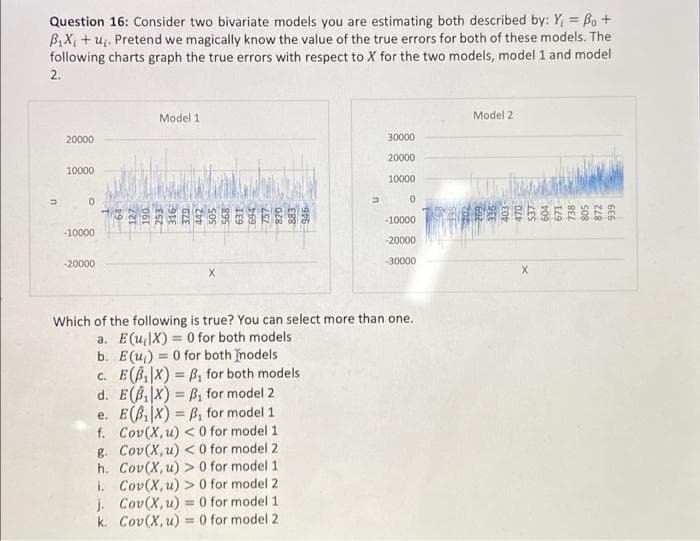Question 16: Consider two bivariate models you are estimating both described by: Y, = Bo + B,X, + u. Pretend we magically know the value of the true errors for both of these models. The following charts graph the true errors with respect to X for the two models, model 1 and model 2. Model 1 Model 2 20000 30000 20000 10000 10000 -10000 -10000 -20000 -20000 -30000 Which of the following is true? You can select more than one. a. E(u|X) = 0 for both models b. E(u) = 0 for both Inodels c. E(B,|x) = B1 for both models d. E(B,|X) = B for model 2 e. E(BX) = B1 for model 1 f. Cov(X, u) < 0 for model 1 g. Cov(X,u) < 0 for model 2 h. Cov(X,u) > 0 for model 1 i. Cov(X, u) > 0 for model 2 j Cov(X,u) = 0 for model 1 k. Cov(X, u) = 0 for model 2 %3D %3D 9 127 061 253 316
Question 16: Consider two bivariate models you are estimating both described by: Y, = Bo + B,X, + u. Pretend we magically know the value of the true errors for both of these models. The following charts graph the true errors with respect to X for the two models, model 1 and model 2. Model 1 Model 2 20000 30000 20000 10000 10000 -10000 -10000 -20000 -20000 -30000 Which of the following is true? You can select more than one. a. E(u|X) = 0 for both models b. E(u) = 0 for both Inodels c. E(B,|x) = B1 for both models d. E(B,|X) = B for model 2 e. E(BX) = B1 for model 1 f. Cov(X, u) < 0 for model 1 g. Cov(X,u) < 0 for model 2 h. Cov(X,u) > 0 for model 1 i. Cov(X, u) > 0 for model 2 j Cov(X,u) = 0 for model 1 k. Cov(X, u) = 0 for model 2 %3D %3D 9 127 061 253 316
Glencoe Algebra 1, Student Edition, 9780079039897, 0079039898, 2018
18th Edition
ISBN:9780079039897
Author:Carter
Publisher:Carter
Chapter10: Statistics
Section10.1: Measures Of Center
Problem 9PPS
Related questions
Question
2

Transcribed Image Text:Question 16: Consider two bivariate models you are estimating both described by: Y Bo+
B,X, + u. Pretend we magically know the value of the true errors for both of these models. The
following charts graph the true errors with respect to X for the two models, model 1 and model
2.
Model 1
Model 2
20000
30000
20000
10000
10000
-10000
-10000
-20000
-20000
-30000
Which of the following is true? You can select more than one.
a. E(uX) = 0 for both models
b. E(u) = 0 for both Inodels
c. E(B|X) = B, for both models
d. E(B,X) = B, for model 2
e. E(B,|X) = B, for model 1
f. Cov(X,u) < 0 for model 1
g. Cov(X, u) < 0 for model 2
h. Cov(X,u) > 0 for model 1
i. Cov(X, u) > 0 for model 2
j. Cov(X, u) = 0 for model 1
k. Cov(X, u) =0 for model 2
%3D
%3D
%3D
GLE
061
Expert Solution
This question has been solved!
Explore an expertly crafted, step-by-step solution for a thorough understanding of key concepts.
Step by step
Solved in 2 steps

Recommended textbooks for you

Glencoe Algebra 1, Student Edition, 9780079039897…
Algebra
ISBN:
9780079039897
Author:
Carter
Publisher:
McGraw Hill

Algebra & Trigonometry with Analytic Geometry
Algebra
ISBN:
9781133382119
Author:
Swokowski
Publisher:
Cengage

Trigonometry (MindTap Course List)
Trigonometry
ISBN:
9781337278461
Author:
Ron Larson
Publisher:
Cengage Learning

Glencoe Algebra 1, Student Edition, 9780079039897…
Algebra
ISBN:
9780079039897
Author:
Carter
Publisher:
McGraw Hill

Algebra & Trigonometry with Analytic Geometry
Algebra
ISBN:
9781133382119
Author:
Swokowski
Publisher:
Cengage

Trigonometry (MindTap Course List)
Trigonometry
ISBN:
9781337278461
Author:
Ron Larson
Publisher:
Cengage Learning